Are you looking to buy your first guitar, but finding it hard to play the ones at the store? Returning to acoustic from electric, but hoping to find something with string action that’s easy on the fingers? Or are you looking to buy someone their first guitar, something easy to play?
Luckily, these days there’s an abundance of low-action acoustic guitars. Low-action (or string-action) simply means that the strings are closer to the fretboard (typically at an action height of 3/32″ on the low E string, 1/16″ on the high E string), making the guitar easier to play. And if it’s easier to play, you’re likely to play it even more! When shopping for a beginner guitar, you really want to check out guitars with low action.
While most any acoustic guitar can be set up with low action, we consulted as a team and chatted with local guitar retailers to come up with our top suggestions for a great low-action acoustic guitar you can buy online today.
So let’s dive right in! We’re going to walk you through our top choices for the most playable acoustic guitars with low action straight from the factory. We’ll also provide some pointers to help guitar players of all skill levels adjust the action to suit your style.
Read more about our review process.
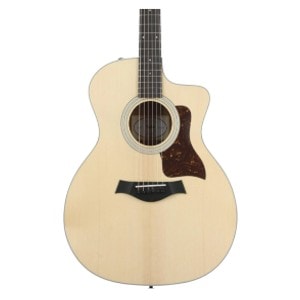
Taylor 214ce-K
Features: Solid spruce top, Venetian cutaway, Tayor ES2 electronics
Benefits: Great upper fret access, Excellent playability, Easy amplification

Fender CD-60SCE
Features: Fishman pickup, Rolled fretboard edges, Solid spruce top
Benefits: Bright tones, Comfortable playing experience, Excellent reliability
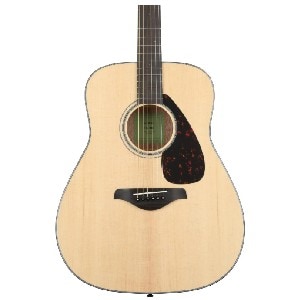
Yamaha FG800
Features: Solid spruce top, Scalloped bracing, Slim satin finished neck
Benefits: Well balanced tone, Excellent projection, Great playability
Contents
Our Top 3
Our number one choice for an easy-to-play guitar with low action is the Fender CD-60SCE. It’s a well-made, beautiful guitar with low action, it sounds fantastic and it’s available for under $500. It also features excellent onboard electronics courtesy of the built-in Fishman pickup. The built-in tuner works in even the most challenging conditions, making the guitar a playability and versatility winner.
If you want something lighter on the pocket, our Budget Pick is the Yamaha FG800, which some say is the world’s best starter guitar. Yamaha make fantastic acoustic guitars for the money (I own a few myself) and the FG800 is no exception, especially if you’re looking for a great budget acoustic guitar that’s super playable. On top of having a great full sound that still manages to come across quite mellow, the FG800 stays in tune well (which can be a challenge at this price point), and the bundle comes with everything you need to get started on your guitar journey!
If you’re less concerned about affordability, we suggest the Taylor 214CE which really is a top-shelf guitar, sporting classic country looks (you know we love country) and incredible balanced but shimmering tones. We particularly liked how the inside of the body is lined with Sapele, which kicks the tone up a notch. It’s consistent and balanced, full-bodied but with a real top-end shimmer. Truly a top-class guitar.
What is Action on a Guitar?
Guitar action means the distance between the strings and the fretboard. When you have a lot of distance (called high action), you have to apply more pressure with your fingers to get a note to ring clearly. If the string is naturally very close to the fretboard (called low action), it is much easier to fret a note (check out our Guitar String Guide to learn more).
Are There Any Disadvantages To Using Low Action?
The two main disadvantages of low action are that it can cause the strings to buzz and it can effect the volume. The reason the strings may buzz is that they’re already so close to the fretboard that they don’t quite have room to vibrate without hitting off other frets. This has an obvious effect on volume.
However if you’re a beginner, the most important thing is that you’re able to play your instrument and enjoy it. Once you build up finger strength, you may want to try out something with higher guitar action to get more volume, but we would definitely suggest crossing that bridge when you come to it.
Individual Reviews
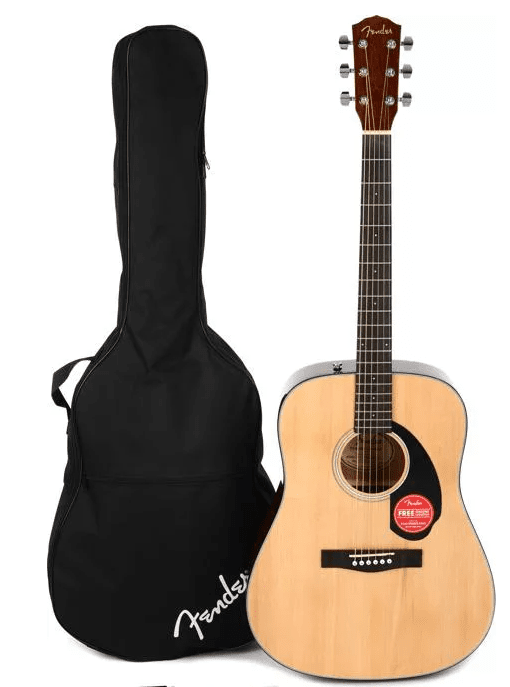
Fender CD-60SCE Dreadnought
An easy playing acoustic with a classic design.
This guitar comes with a killer Fishman pickup system, is well made, and thanks to the low action, it's exceptionally comfortable.
The Fender CD-60SCE features Fender’s classic shape and style in a very affordable package. We’ve covered the CD-60 line before, and the SCE is top of the bunch. You’ll get great sound from both the CD-60SCE and its budget brother guitar, the CD-60S. The CD-60SCE offers more versatility due to the fact it can be plugged into an amplifier or otherwise amplified for playing shows either alone or with a band. On top of that, the cutaway in the body makes accessing the higher frets a breeze. This is a guitar with incredible playability and versatility right out of the box.
This dreadnought-style acoustic features a solid spruce top, mahogany back and sides, mahogany neck, walnut fingerboard, and chrome die-cast tuning machines. It does feature a plastic nut, but that is cheap to replace should you run into any tuning issues.
Sound-wise, the guitar is very full-bodied. The spruce top gives it more projection and a very pronounced top end. The guitar features an easy-to-play neck with rolled edges, which combined with the low action out of the box, results in a guitar that is effortless.
Where the CD-60SCE excels above the CD-60S (and many other budget guitars) is the onboard electronics, courtesy of the Fishman pickup. The controls are easy to use to get a variety of sounds out of the guitar, and the onboard tuner works even in difficult conditions.
One of the other things that makes this a perfect budget buy is that it comes with an essentials bundle (tuner, capo, strap and such) and a hard-shell case. That is very rare in guitar bundles, especially when a case often costs upwards of $100 on its own.
Easily our Top Pick for the best-value, low-action guitar you can buy today.

Yamaha FG800
Exceptional build quality and great feel.
With this Yamaha you're not only getting a slim neck and a low action, but you're also getting quality tone woods at an unbeliveable price.
The Yamaha FG800 is a dreadnought guitar, meaning it is larger and has a deeper sound than most smaller acoustic guitars. In practical terms, that makes it perfect for playing alone because the full sound provides a wide tonal range to complement a singer.
The guitar has a spruce top, Nato/Okume back and sides, a nato neck with rosewood fingerboard and bridge, diecast tuners and an adjustable truss rod. It also features a classic tortoise-shell pickguard to give you the old-school Johnny Cash vibes.
Tone wise, the FG800 is full but mellow, with a warm, sound rich in the lower and mid range. This is what you would expect from the Elixir Nanoweb strings that come on Yamaha acoustics. It is super comfortable to play and while it is of course a beginner or budget guitar, it’s made by the biggest manufacturer of beginner guitars, so it doesn’t feel cheap like many of the generic unknown guitar brands littering the market.
As an added bonus, the Yamaha FG800 comes in a bundle that includes everything a new guitarist needs to get up and running. This includes a tuner, a new set of strings, a capo to play some more unusual songs, and a bag to make it easy to transport your guitar from home to practice or lessons.
Without question, a great buy if you’re in the market for a budget-priced acoustic guitar that’s easy to play and sounds killer.
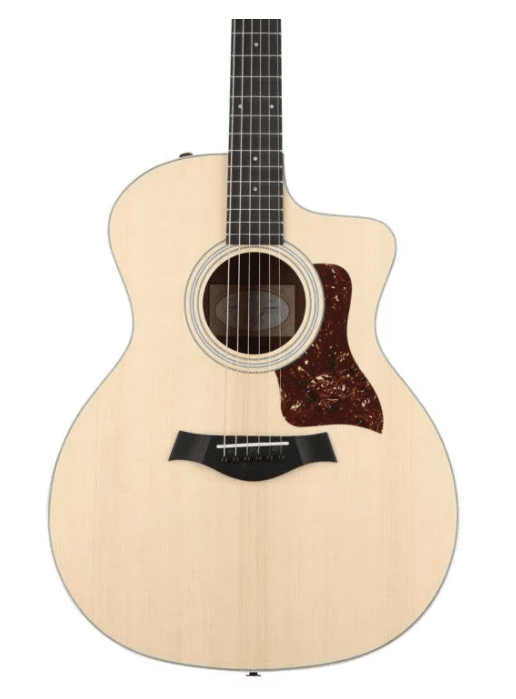
Taylor 214ce-K Grand Auditorium Koa Natural ES2
Beautiful to look at and a joy to play.
If you want an almost impossibly low action without the fret buzz that usually accompanies such a set up, look no further than this Taylor.
The Taylor 214ce is considered an upper-mid-tier acoustic guitar, which means it’s the best guitar you can get before you start paying for prestige. Of course, Taylor is known for making some of the best acoustic guitars on the market, from the popular Baby Taylor series right up through the $10k Custom Grand Auditorium series. With the 214ce, you’re hitting the sweet spot, and getting a ton of guitar for your money from one of the best guitar manufacturers in the acoustic business.
It has a solid sitka spruce top, layered Indian rosewood back and sides, an American mahogany neck with a beautiful African ebony fretboard. The inside of the guitar is lined with Sapele, which gives it a great warm tone. In addition, the guitar sports a Taylor Expression System 2 pickup with active bass and treble controls.
Sound-wise, the Taylor 214ce has an amazing low-end richness but feels very responsive to changes in playing style. The sitka spruce body with the sapele lining delivers sound fantastic grain, power, and sustain. It’s easy to see why it’s considered the ideal tonewood for more mid- to high-range guitars. It features a deep Venetian cutaway, providing excellent upper access, and has a neck that has been described as “the smoothest in the business.” The overall quality of this guitar is more in the range of guitars twice its price (full review here).
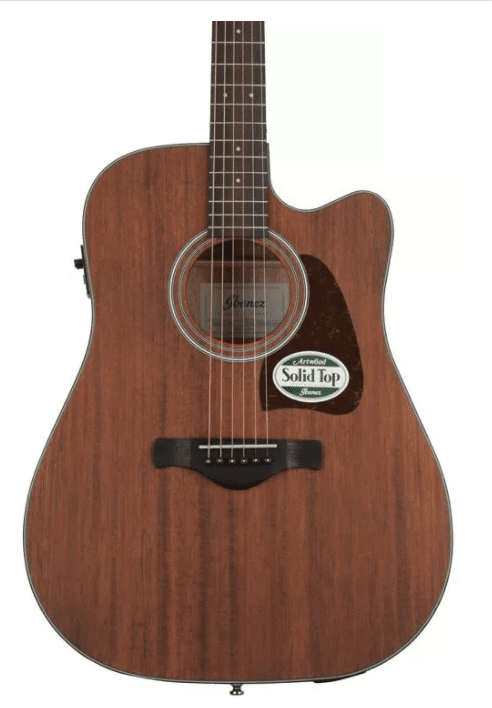
Ibanez AW54CEOPN Artwood Dreadnought
Big tones without the usual discomfort.
Full size dreadnoughts often sacrifice comfort for big, booming voices - but not this one. It has a low string height, and excellent intonation considering the price.
The Ibanez AW54CEOPN is from Ibanez’s celebrated Artwood line. At this price, it offers the best balance of value and features.
It has a mahogany body with an Okoume back and a gorgeous open-pore finish, a rosewood fretboard and bridge, an ovangkol bridge, chrome die-cast tuners, Ibanez’s T-bar undersaddle pickup and an AEQ-TP2 Preamp, topped off with Fishman electronics.
One of its other features is a cutaway that allows you easy access to the higher frets, key for those players using a capo to transpose songs to a higher register.
Tone-wise, this has a rich and dark timber and the smaller size means it’s super comfortable to play. It also comes already setup with wonderful low action (it is an Ibanez after all). Combined with its size and slim neck profile, this makes it a really enjoyable guitar to spend time with. Excellent for beginners and experienced players alike.

Martin DJR-10E
Classic Martin tones with premium electronics.
This is a guitar that's affordably priced for the bedroom player, and at the same time is gig ready out of the box. It boasts high end Fishman electronics and an action so smooth, you won't want to put it down.
The Martin DJr-10E is dreadnought junior, so it’s not as big as a regular dreadnought, but for sure not as small as something like a Baby Taylor. It features a Sitka spruce top, Sapele back and sides, select hardwood neck, richlite bridge and fingerboard. It also features premium Fishman Sonitone electronics with the controls semi-hidden inside the sound hole.
Speaking of sound, this Martin has the kind of balanced sound you’d expect from a guitar that’s both dreadnought and junior. The slim taper neck and low action make it play like an electric, and the comfortable body size leaves you with a guitar you can sit with for hours. For sure an absolute gem, even among guitars with low action.
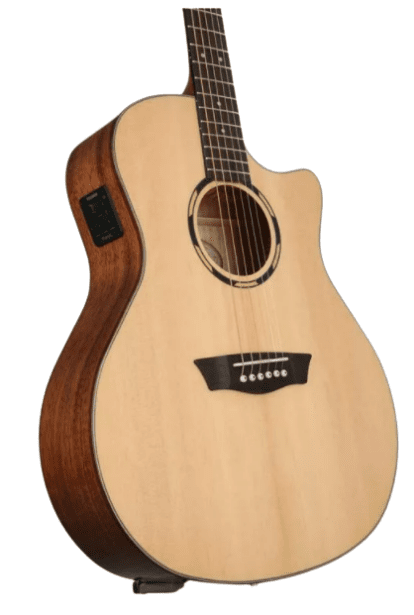
Washburn Woodline O10SCE
Excellent playability and solid woods throughout.
If you like a guitar with low action, this Washburn delivers right out of the box. In addition to great playability, it offers excellent fit and finish, and great tone woods, too.
The WLO10SCE is part of the fantastic Woodbine series, which is Washburns mid-tier guitar, offering as they put it “a mix of elegance, musicality and affordability.” That being said, you do get a lot for your money.
The guitar has a solid spruce top, mahogany back and sides, satin mahogany neck, and rosewood fingerboard. It also has a number of higher-quality parts such as a GraphTech NuBone nut and saddle, a Fishman Presys II 301T tuner/preamp, and walnut binding. Overall, a very high-quality instrument for the price.
Sound-wise, the Woodbine is very smooth with a nicely rounded top end. It has a full midrange and the bass is deep without being boomy, giving you everything you need for a fingerpicking machine! The neck is very comfortable and the low action combined with the smooth single-cutaway design make it super playable. Definitely one for your short list of guitars with low action.
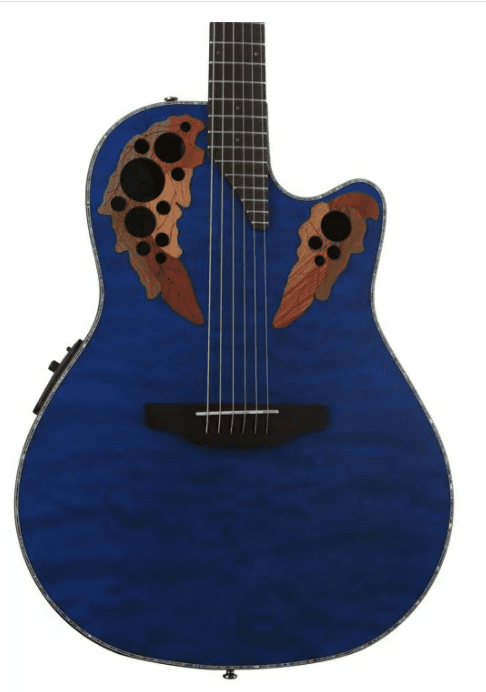
Ovation Celebrity Elite Plus
Unique looks and high end features.
For those who like to stand out, this guitar is a sure fire way to do so. The shallow curved bowl back and low string height make it comfortable for beginners, and lightning fast for more advanced players.
Ovation makes some of the most unique-looking acoustics, especially at this sub-$600 price range, and the CE44 is no exception. This particular model is part of Ovation’s “Elite Plus” range, which means you’re getting an exotic top with abalone inlays, one step above the regular “elite” offering. Pair that with the superb sound and onboard electronics, and you can see why we chose it as our Top Model low-action acoustic, price be damned.
Sporting a Lyrachord cutaway body with a figured top, this one is a real looker. The neck is a satin Nato, with a rosewood fingerboard and abalone inlays. It also has a rosewood bridge and gold die-cast tuners.
Ovation are known for their superior onboard electronics and the CE44 is no exception, featuring an Ovation Slimline pickup and OP-4BT preamp system with three-band EQ, volume/gain control, onboard tuner and low-battery light.
In addition to being a famously easy-to-play guitar, the Ovation is light and comfortable both sitting and standing, and the neck is fast and smooth with string action to die for.
Sound-wise, the mini-soundhole design gives the guitar clear highs and focused bass response when played naturally. Plugged in (which is where ovations shine), the sound is full and yet delicate, with remarkable clarity. If you’re looking for something more on the acoustic side than a straight-up hybrid guitar, this should be your go-to.
How to Lower the Action on an Acoustic Guitar
If you do decide to buy a guitar with higher action, you still have options to make a few simple (and not so simple) adjustments to the string height, so it plays like the best guitars with low action. While every guitar should be set up individually, the range you’re typically looking for in action height is to have the high E at about 1/16″ (1.6mm for our metric friends), and the low E around 3/32″ (2.44mm).
You can of course ask the store or your local luthier to lower the action, or adjust the action step-by-step yourself, although I would warn that lowering the action on an acoustic is a far more complex job than on an electric.
There are three ways to adjust the action on a guitar, that range broadly from easier to harder. Bear in mind, if you’re buying a budget guitar for a new player, you’ll want to take it to a guitar store to get them to do all of the below. Just ask for a setup.
Truss Rod Adjustment
Most electric and acoustic guitars have a steel or graphite rod called a truss rod that runs down the neck of the guitar to provide reinforcement. A guitar tuned to pitch has several hundred pounds of pressure on the neck, which would almost certainly snap the wood itself were there no truss rod present. You can adjust the truss rod to give less or more relief, which is basically the amount the neck bows in either direction.
Adjusting the truss rod can bring the string action closer to the neck, but it can have several ripple effects that you want to be wary of. Typically, most people can adjust a truss rod, but if you’re a beginner you will want to move forward with caution.
We have a whole article on truss rods and how to adjust them, but if you’re in a pinch, here’s a great video explaining these effects, and how to adjust your truss rod.
Nut Adjustment
The next step in developing guitars with low action is adjusting the nut. You’re looking at directly deepening the nut slots string-by-string to lower the guitar’s action. If the action is too low already, you’ll need to add a shim behind the nut or replace it altogether. If you do replace it, you’ll want to go for Tusq. We explain why in this guide to tusq nuts vs bone.
The trick here is you need to make sure you maintain the correct break angle coming out of the nut, as any adjustment potentially has a huge effect on your intonation and tuning stability. This is definitely not one for new guitar players, so proceed with caution.
Here’s a great video that will walk you through a nut adjustment.
Saddle Adjustment
This is where things get more complicated. Ideally, you want the radius of the saddle to match the radius of the fretboard. The better they match, the better the guitar action and the better the playability of your guitar. A tighter saddle will result in higher than necessary string height, and flatter will give you lower string action that may buzz. All the best guitars with low action will have a saddle that has been worked especially for this purpose.
On an electric, the string saddles typically have some sort of adjustment screws to make this process a breeze. With an acoustic, you’ll need to file or sand the saddle to lower it, or add a shim to raise it in order to get just the right string height.
Here’s a great video on how to do this – though if you’re not confident I would for sure suggest taking it to the shop.
Check out our full guide for more on guitar action!
Final Thoughts
Hopefully, this list gives you a good starting point to choose a smooth-playing, low-action guitar. It’s super important to make your guitar as comfortable as possible because the goal is to play more, and anything that makes playing more enjoyable gets you closer to that goal.


